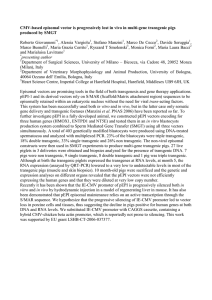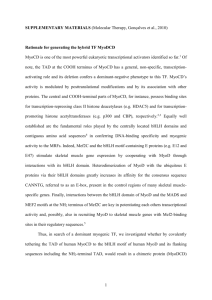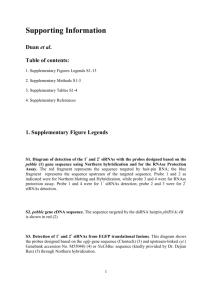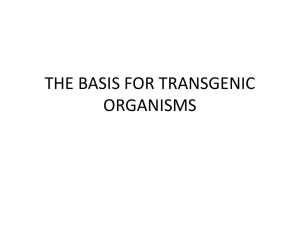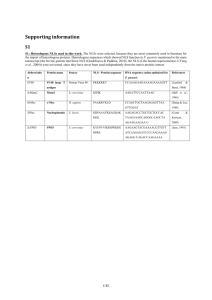Online Methods
advertisement
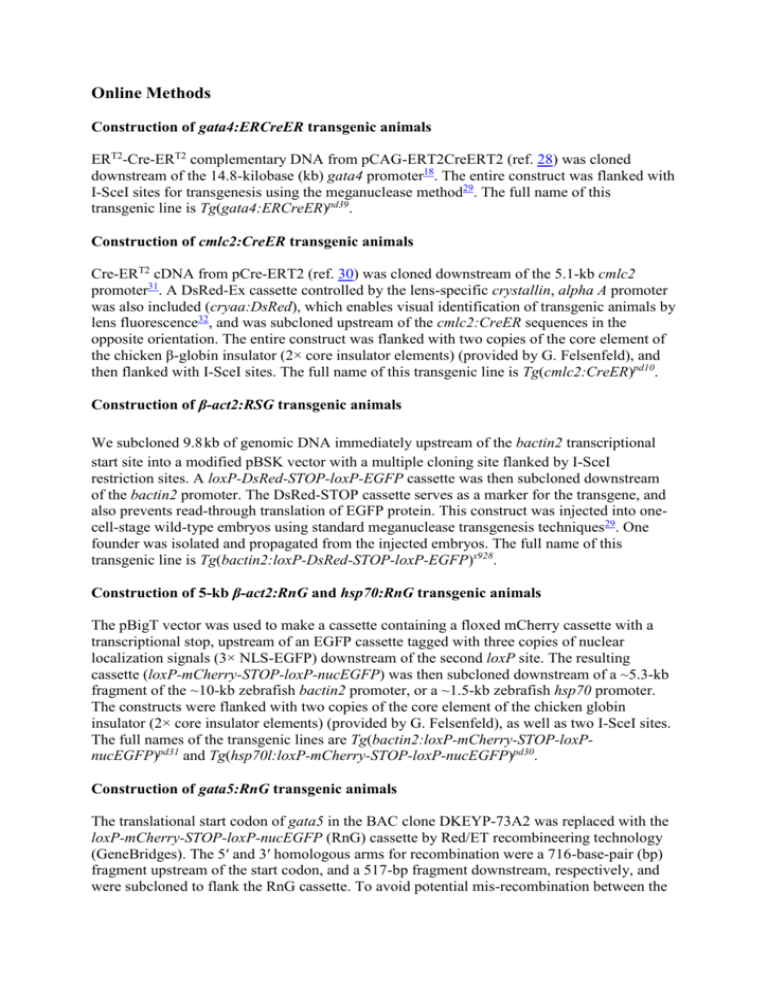
Online Methods Construction of gata4:ERCreER transgenic animals ERT2-Cre-ERT2 complementary DNA from pCAG-ERT2CreERT2 (ref. 28) was cloned downstream of the 14.8-kilobase (kb) gata4 promoter18. The entire construct was flanked with I-SceI sites for transgenesis using the meganuclease method29. The full name of this transgenic line is Tg(gata4:ERCreER)pd39. Construction of cmlc2:CreER transgenic animals Cre-ERT2 cDNA from pCre-ERT2 (ref. 30) was cloned downstream of the 5.1-kb cmlc2 promoter31. A DsRed-Ex cassette controlled by the lens-specific crystallin, alpha A promoter was also included (cryaa:DsRed), which enables visual identification of transgenic animals by lens fluorescence32, and was subcloned upstream of the cmlc2:CreER sequences in the opposite orientation. The entire construct was flanked with two copies of the core element of the chicken β-globin insulator (2× core insulator elements) (provided by G. Felsenfeld), and then flanked with I-SceI sites. The full name of this transgenic line is Tg(cmlc2:CreER)pd10. Construction of β-act2:RSG transgenic animals We subcloned 9.8 kb of genomic DNA immediately upstream of the bactin2 transcriptional start site into a modified pBSK vector with a multiple cloning site flanked by I-SceI restriction sites. A loxP-DsRed-STOP-loxP-EGFP cassette was then subcloned downstream of the bactin2 promoter. The DsRed-STOP cassette serves as a marker for the transgene, and also prevents read-through translation of EGFP protein. This construct was injected into onecell-stage wild-type embryos using standard meganuclease transgenesis techniques29. One founder was isolated and propagated from the injected embryos. The full name of this transgenic line is Tg(bactin2:loxP-DsRed-STOP-loxP-EGFP)s928. Construction of 5-kb β-act2:RnG and hsp70:RnG transgenic animals The pBigT vector was used to make a cassette containing a floxed mCherry cassette with a transcriptional stop, upstream of an EGFP cassette tagged with three copies of nuclear localization signals (3× NLS-EGFP) downstream of the second loxP site. The resulting cassette (loxP-mCherry-STOP-loxP-nucEGFP) was then subcloned downstream of a ~5.3-kb fragment of the ~10-kb zebrafish bactin2 promoter, or a ~1.5-kb zebrafish hsp70 promoter. The constructs were flanked with two copies of the core element of the chicken globin insulator (2× core insulator elements) (provided by G. Felsenfeld), as well as two I-SceI sites. The full names of the transgenic lines are Tg(bactin2:loxP-mCherry-STOP-loxPnucEGFP)pd31 and Tg(hsp70l:loxP-mCherry-STOP-loxP-nucEGFP)pd30. Construction of gata5:RnG transgenic animals The translational start codon of gata5 in the BAC clone DKEYP-73A2 was replaced with the loxP-mCherry-STOP-loxP-nucEGFP (RnG) cassette by Red/ET recombineering technology (GeneBridges). The 5′ and 3′ homologous arms for recombination were a 716-base-pair (bp) fragment upstream of the start codon, and a 517-bp fragment downstream, respectively, and were subcloned to flank the RnG cassette. To avoid potential mis-recombination between the RnG cassette and an endogenous loxP site in the BAC vector, we replaced the vector-derived loxP site with an I-SceI site using the same technology. The final BAC was purified with nucleobond BAC 100 kit (Clontech), and co-injected with meganuclease into one-cell-stage zebrafish embryos. The full name of this transgenic line is Tg(gata5:loxP-mCherry-STOPloxP-nucEGFP)pd40. Construction of cmlc2:DsRed2 transgenic animals DsRed2 cDNA was cloned behind the 5.1-kb cmlc2 promoter, and the entire cassette was flanked with I-SceI sites. The full name of this transgenic line is Tg(cmlc2:DsRed2)pd15. 4-HT labelling and quantification of EGFP fluorescence in cmlc2:CreER; β-act2:RSG animals To determine the kinetics of 4-HT labelling, we gave single 20 μl intraperitoneal injections of a low dose (2.5 μg ml-1) of 4-HT to uninjured cmlc2:CreER; β-act2:RSG adults. We detected recombination by myocyte EGFP fluorescence in ventricular sections at 1 day post-injection (d.p.i.), and at increased frequency (~20% of ventricular myocytes) and intensity by 2 d.p.i. Examination of ventricular sections at 3, 4 and 5 days after injection indicated EGFP labelling frequencies similar to 2 d.p.i. These findings provided evidence that intraperitoneally injected 4-HT is no longer able to stimulate new recombination events in ventricular cardiomyocytes of adult zebrafish after 2 d.p.i. To quantify Cre-mediated release of EGFP expression in lineage tracing experiments with cmlc2:CreER; β-act2:RSG animals, three sections including the regenerate were selected from each heart. For uninjured control hearts, the three largest sections were selected from each heart as described previously27. We used the DsRed+ area to reflect total myocardial section surface area, as the background expression of DsRed persists in cardiac muscle after 4-HT injections in β-act2:RSG transgenic fish. This is probably due to multiple transgene copies, allowing escape of some floxed DsRed cassettes from Cre-mediated recombination (Supplementary Fig. 2). Images of single optical slices of the ventricular apex were taken at ×40 (1,024 × 1,024 pixels) by adjusting gain to detect EGFP or DsRed signals above the background level. An area (504 × 504 pixels) at the injured apex was chosen to include most of the regenerate in the image, and cropped using Photoshop software. An identical area was cropped at the ventricular apex for uninjured animals. EGFP+ and DsRed+ areas were quantified in pixels by ImageJ software, and the percentage of EGFP+ versus DsRed+ areas was calculated. Quantification of EGFP fluorescence in gata4:EGFP and gata4:ERCreER; β-act2:RSG animals To quantify EGFP+ areas, three sections including the wound/regenerate were selected from each heart. Images of the ventricular apex were taken at ×20 using a Leica DM6000 microscope with a Retiga-EXi camera (Q-IMAGING). An area (109 × 109 pixels for gata4:EGFP animals and 73 × 73 pixels for gata4:ERCreER; β-act2:RSG animals) was designated at each of the lateral wound edges and cropped using Photoshop software (see Supplementary Fig. 2 for cartoon). An area (109 × 218 pixels for gata4:EGFP animals and 73 × 146 pixels for gata4:ERCreER; β-act2:RSG animals) non-overlapping with the lateral areas was designated and cropped at the injury site. EGFP+ areas were quantified in pixels by ImageJ software, and the number of pixels summed and averaged to yield an edge EGFP+ area and injury site EGFP+ area for each heart. Transmission electron microscopy Injured hearts were fixed in 2.5% glutaraldehyde, 2% formaldehyde in 0.1 M sodium cacodylate buffer. Tissue was post-fixed in 1% OsO4, dehydrated, embedded in Spurr’s resin (EMS), and sectioned to 70–90 nm thickness using Ultracut or Ultracut E ultra-microtomes (Leica). The sections were counterstained with uranyl acetate and lead citrate. Microscopy was performed on a FEI Tecnai G2 Twin transmission electron microscope and images were obtained using a Hamamatsu ORCA-HR digital camera and AMT software. Optical mapping Fish were anaesthetized with 0.1% 3-aminobenzoic acid methyl ester, and hearts were isolated within 30 s and placed in Tyrode solution containing (in mM) Na+ (136), K+ (5.4), Mg2+ (1.0), PO43- (0.3), Ca2+ (1.8), glucose (5.0) and HEPES (10.0) at pH 7.4. Hearts were loaded for 10 min with the transmembrane-potential-sensitive dye di-4-ANEPPS (D-1199, Invitrogen), which was dissolved in Tyrode solution. After staining, the preparations were transferred into the recording chamber (Warner Instruments), which contained Tyrode solution supplemented with 30 μM of the excitation-contraction decoupler blebbistatin (EMD Chemicals) to inhibit contraction during optical measurements. The chamber was mounted onto the stage of an inverted microscope ( TE-2000U, Nikon) equipped with a high-speed CCD camera ( Cardio CCD-SMQ, Redshirt Imaging) with an 80 × 80 pixel frame. Hearts were point-stimulated at 60 beats-per-minute using a fine platinum electrode held in place near the base of the heart using a micro-manipulator. This electrode location eliminated artefactual increases in conduction velocity due to simultaneous local capture of multiple pixels proximate to the stimulus site (that is, virtual electrode effects)33. Optical action potentials were recorded from the epicardial surface of the apex. Fluorescence was excited with a 120 W metal-halide arc lamp (X-Cite 122, Exfo) and filtered at 540 ± 25 nm. Fluorescence emission was passed through a long-pass emission filter (585 nm) before being focused onto the camera. Optical magnification was ×2 resulting in 11-μm spatial resolution between recording pixels. The camera was operated at 2,000 frames-per-second and signals were digitized with 14-bit precision. Signals were digitally filtered in the temporal (900 Hz cutoff) and spatial (4pixel weighted average) domains to reduce noise. Action potentials recorded with this system depicted the time course of membrane potential change with fidelity comparable to action potentials recorded with patch-clamp technique34. Optical mapping fluorescence data analysis Acquired fluorescence data were analysed using custom software written specifically for the analysis of action potentials recorded optically from the zebrafish heart ( MatLab, Mathworks). Action potential duration (APD) was defined as the time interval between 20% depolarization and 80% return or repolarization to resting potential (APD80). Action potential upstroke velocity was derived from the maximum of the first time-derivative of the action potential. Activation time was defined as the time of 50% depolarization during the rising phase of the action potential. We have used this criterion of local activation because the time at half-maximum depolarization has been shown previously in computer simulations to correspond closely to the maximum cellular sodium influx35. Isochronal maps that display the position of the wavefront at constant time intervals (2 ms) were constructed from the activation times using the contour plotting functions provided by the Matlab software. Conduction velocity vector fields were estimated from the activation times using an established algorithm described previously36. In brief, local velocity vectors, which represent the magnitude and direction of the propagating depolarizing wave at each recording site, were calculated by fitting the depolarization time measured at each site to a parabolic twodimensional surface. The components of the velocity vector at each site were calculated from the components of the gradient on this surface. Conduction velocities were averaged across sites located within a 200 × 200 μm square near the apex of each heart (Supplementary Fig. 10).
